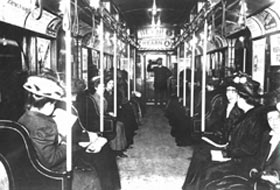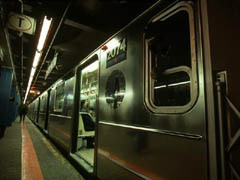Underground Railroads

A short history of subterranean transport in America
by Dan Shafto |
 The interior of a women's car on the early New York subway. Modern systems not only integrate the sexes, but also modes of transportation. (Source/Photos to Go) Related Links
Subway Web Sites
 Boston's "T," the first subway in America, opened on September 1, 1897. (Source/Arttoday) |
"Had enough traffic?"
This advertisement for San Francisco's Bay Area Rapid Transit (BART) system expresses an age-old frustration for many American urbanites. Issues of overcrowding and congestion have plagued U.S. cities since the forties, and the total U.S. population has increased by more than twenty million each decade since. It is only in the past 30 years that these issues have been addressed through innovative new modes of public transportation.
Rapid Population Growth
From 1810 through the mid-1800's, New York City's population increased, on average, 58% each decade. Amid this dramatic population increase, it was jokingly said that one could travel halfway from New York to Philadelphia quicker than one could travel the length of Broadway. This Manhattan boulevard was often in such a state of chaos that it required the forceful presence of police officers to maintain order.
'Pneumatic Transit'
The dire situation of New York's streets prompted publisher Alfred Ely Beach to search for an alternative mode of transportation. In February of 1870, Beach opened a below-ground transportation system that set a precedent in subterranean travel.
"Pneumatic Transit," as the system was known, consisted of a 312-foot wind tunnel and a 22-passenger car propelled over the tracks by a 100-horsepower fan. While this curious solution to urban transport was not the wave of the future, it paved the way for the American subway.
Boston's 'T'
Toward the end of the 19th century, Boston found itself in a similar situation to New York City. Rapid population growth caused an enormous strain on traffic in the downtown area, and many commuters began to rely extensively on the street-level trolley system.
Owned and operated by the West End Company, these electric-powered trolleys contended with the large number of cars and pedestrians also crowding Boston's streets. Under increasing public pressure, West End partnered with the Boston Transit Commission to fund the excavation and construction of America's first subway. This underground system, nicknamed the "T," opened on September 1, 1897.
Seedling Subways
New York opened its first subway - merely 9 miles long - in October of 1904. Philadelphia constructed a system combining subway lines with above-ground and elevated trolley lines, much like the one in use in Boston, between 1905 and 1908. These subways were well-received and expanded soon after their inception.
Subways continued to grow in number and usage through the first half of the twentieth century. Despite a short pause during World War I and II, a post-war optimism spurred growth for subways. According to Brian J. Cudahy in his book, Cash, Tokens, and Transfers, in 1926 the average American took 162.7 transit trips a year. In 1946, this number reached 177.7.
After 1946, however, Americans turned to the automobile in droves, and subway ridership decreased for the next 25 years - until the early 1970's.
The Transit "Renaissance"
The building of San Francisco's BART system marked the beginning of a revival period for subways. In addition to 71 miles of track, BART was the first centrally-operated rapid transit system in American history.
On the heels of BART's success, Baltimore, Miami, Atlanta, and Washington, D.C. opened or revamped their underground railway systems. Even expansive, car-dominated Los Angeles made plans for a new subway, sections of which opened in 1998.
Meanwhile, the older rail lines in New York, Boston, and Philadelphia made plans for improvements to their well-worn systems.
Overcrowding has plagued American cities for more than one hundred years. Fortunately, over the last few decades, transit patronage has steadily increased. While it is nowhere near the levels achieved prior to introduction of the automobile, it shows more and more people are saying "no" to the highway and "yes" to existing subway systems.
Sources: Holtz Kay, Jane, Asphalt Nation. University of California Press. Berkley, 1997. Cudahy, Brian J., Cash, Tokens, and Transfers. Fordham University Press. New York: 1990.







